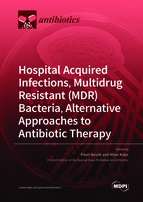Hospital Acquired Infections, Multidrug Resistant (MDR) Bacteria, Alternative Approaches to Antibiotic Therapy
A special issue of Antibiotics (ISSN 2079-6382).
Deadline for manuscript submissions: closed (31 December 2021) | Viewed by 27186
Special Issue Editors
Interests: antibiotic resistance; molecular biology; hospital infections; natural compounds
Special Issues, Collections and Topics in MDPI journals
Interests: bacterial infections; antibiotic therapy; antibiotic resistance
Special Issues, Collections and Topics in MDPI journals
Special Issue Information
Dear Colleagues,
Resistance to known and currently used antibiotics represents a growing issue worldwide. It poses a major problem in the treatment of infectious diseases in general and hospital-acquired infections in particular. This is in part due to the overuse and misuse of antibiotics in past decades, which led to the selection of highly resistant bacteria and even so-called superbugs – multidrug-resistant (MDR) bacteria. Nosocomial infections, particularly, are often caused by MDR bacterial pathogens and the treatment of such infections is very complicated and extensive, often leading to various side effects. Even though MDR bacteria are widespread globally, their epidemiology varies by region. Hospital-acquired infections caused by MDR bacteria remain an unresolved problem in the healthcare system. A very important part of the overall therapeutic approach is the microbiological examination of adequate clinical materials, in particular blood culture tests. The obtained results allow targeted antibiotic therapy based on the identification of bacterial pathogens and the determination of their susceptibility/resistance to antibiotics. Molecular genetic methods are an integral part of solving the problem of bacterial resistance. Only adequately selected molecular typing methods may confirm or rule out epidemiologically related cases. If a new outbreak or merely increased rate of MDR bacteria is reasonably suspected, the clonal relationship of strains needs to be analyzed to reveal the source or route of transmission.
At the same time, the development of novel antibiotics is lagging with very few new ones in the pipeline. Finding viable alternatives to treat such infections may help to overcome these therapeutic issues.
This Special Issue will publish papers exploring developments in the field of bacterial resistance, mainly in the hospital settings, adequate antibiotic therapy, and identification of compounds useful to battle this growing issue.
Prof. Dr. Pavel Bostik
Prof. Dr. Milan Kolar
Guest Editors
Manuscript Submission Information
Manuscripts should be submitted online at www.mdpi.com by registering and logging in to this website. Once you are registered, click here to go to the submission form. Manuscripts can be submitted until the deadline. All submissions that pass pre-check are peer-reviewed. Accepted papers will be published continuously in the journal (as soon as accepted) and will be listed together on the special issue website. Research articles, review articles as well as short communications are invited. For planned papers, a title and short abstract (about 100 words) can be sent to the Editorial Office for announcement on this website.
Submitted manuscripts should not have been published previously, nor be under consideration for publication elsewhere (except conference proceedings papers). All manuscripts are thoroughly refereed through a single-blind peer-review process. A guide for authors and other relevant information for submission of manuscripts is available on the Instructions for Authors page. Antibiotics is an international peer-reviewed open access monthly journal published by MDPI.
Please visit the Instructions for Authors page before submitting a manuscript. The Article Processing Charge (APC) for publication in this open access journal is 2900 CHF (Swiss Francs). Submitted papers should be well formatted and use good English. Authors may use MDPI's English editing service prior to publication or during author revisions.
Keywords
- Multidrug resistant bacteria
- Molecular typing
- Hospital acquired infections
- Antibiotic therapy
- Antibiotic compounds








